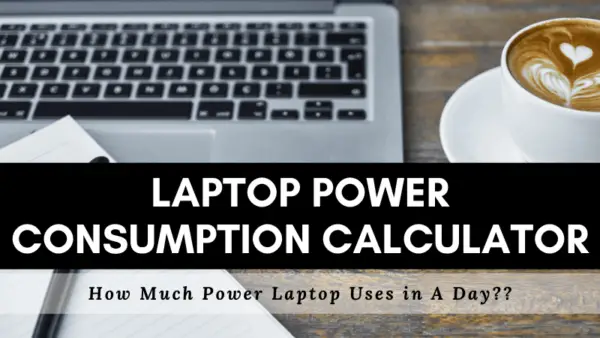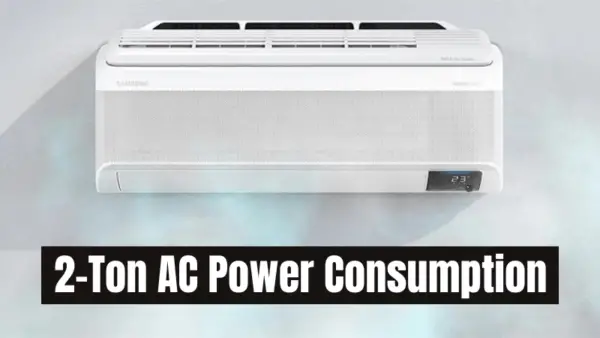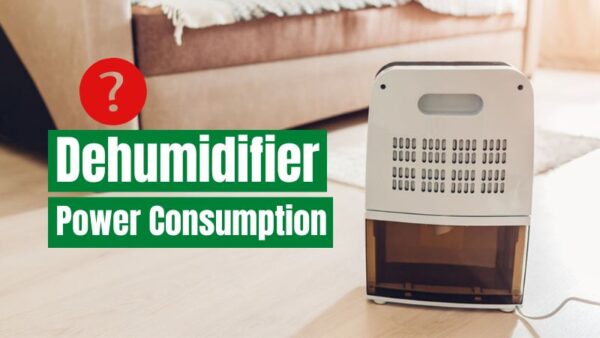If you are planning to buy a new semi-automatic washing machine or wondering how much electricity your existing semi-automatic washing machine is consuming then this article is for you. In this article, we will calculate the power consumption of a semi-automatic washing machine and also look at how much it costs to use one.
Semi-automatic washing machines are rated between 200 watts to 500 watts. Generally, the bigger the capacity of the washing machine, the higher the wattage.
For one full load of washing, a semi-automatic washing machine consumes anywhere between 0.25 kWh to 0.35 kWh of electricity.
Read the article to know more about semi-automatic washing machine power consumption and how you can calculate your washing machine’s power consumption using a simple calculator.
How To Calculate Semi-Automatic Washing Machine Power Consumption:
The power consumption of a semi-automatic washing machine (for that matter any electrical appliance) depends upon two main things,
- First is the wattage of your washing machine & operational hours,
- And second is the electricity tariff in your area.
Before we jump into calculating the power consumption of your semi-automatic washing machine let’s see what these terms are and how you can find out your semi-automatic washing machine’s wattage and the electricity tariff of your locality.
If you already know these terms and just want to use the calculator then please scroll down to use the calculator.
Semi-automatic washing machine wattage:
The average wattage of semi-automatic washing machines varies from 200 Watts to 500 Watts. Generally, the bigger the size of the washing machine, the higher the wattage, and the higher the power consumption.
A semi-automatic washing machine has two electric motors which consume the bulk of the electricity. One electric motor is the washing motor mounted on the washing side bucket which basically rotates during the washing cycle.
And the other electric is mounted on the drying bucket which runs while you dry your clothes.
Both the electric motors have different wattage (generally washing motor is big in size).
You can find the wattage of your top-load semi-automatic washing machine by reading the label on it or in the product manual.
For your reference, I have built the following table that shows the wattage of different sizes of semi-automatic washing machines.
| Washing machine capacity | Washing motor wattage | Spin motor wattage | Avg Wattage |
|---|---|---|---|
| 6 kg Semi-Automatic | 400 Watts | 160 Watts | 280 Watts |
| 7 kg Semi-Automatic | 340 Watts | 160 Watts | 250 Watts |
| 8 kg Semi-Automatic | 340 Watts | 150 Watts | 245 Watts |
| 9 kg Semi-Automatic | 360 Watts | 240 Watts | 300 watts |
| 10 kg Semi-Automatic | 410 Watts | 360 Watts | 385 Watts |
Semi-automatic washing machines only come in top-load configuration,hence, all the calculation we will do is for top-load semi-automatic washing machine.
If you are confused about what a watt is then here is a quick explanation,
Watt is the unit of power. It means the rate at which a device consumes or produces electricity. For example, a 360-watt semi-automatic washing machine consumes power at a rate of 360 watts per hour, it does not mean that the washing machine consumes 360 units of electricity, it means it will consume power at a rate of 360 watts every hour.
So, in short, the wattage of a top-load semi-automatic washing machine lies between 200 watts to 500 watts and you can find it by looking at the label on it.
Semi-automatic washing machine power consumption:
With this information in your hand, you are ready to find the power consumption of your top-load semi-automatic washing machine.
Let me show you an example,

I have selected this 6.5 kg semi-automatic washing machine, and we will calculate its power consumption per wash, in a month, and in a year.
The rated wattage of this washing machine is 340 Watts for the washing motor and 150 Watts for the spin motor that is used for drying.
Therefore, the average wattage is: 245 Watts (340W+150W/2)
To calculate the power consumption of your washing machine, you can use this simple formula:
Power consumption of an appliance = Wattage of the appliance X operational hours
Let’s calculate the power consumption of this 6.5 kg washing machine per wash cycle.
1 wash cycle basically means the time the washing machine takes to complete the entire wash cycle (rinse, wash, dry).
It is around 50 minutes to 1 hour for most machines.
Wattage in our case is 245 watts and operational hours are 1 (since we are doing the calculation for a single wash).
Hence, by using the above formula.
Power consumption of a 6.5 kg washing machine per wash (1 hour) = 245 watts X 1 hour = 0.245 kWh
Similarly, I have calculated the per-wash power consumption of different sizes of semi-automatic washing machines.
| Washing Machine Size | Semi Automatic Washing Machine Power Consumption Per Wash. |
|---|---|
| 6 kg semi-automatic washing machine | 0.28 kWh |
| 7 kg semi-automatic washing machine | 0.25 kWh |
| 8 kg semi-automatic washing machine | 0.245 kWh |
| 9 kg semi-automatic washing machine | 0.30 kWh |
| 10 kg semi-automatic washing machine | 0.385 kWh |
Let’s calculate the Daily, monthly, and annual power consumption of a semi-automatic washing machine.
| Washing Machine Capacity | Daily Power Consumption (1 Cycle @Full Load) | Monthly Power Consumption (30 Cycles @Full Load) | Annual Power Consumption (365 Cycles @Full Load) |
|---|---|---|---|
| 6 kg washing machine | 0.28 kWh | 8.4 kWh | 102.2 kWh |
| 7 kg washing machine | 0.25 kWh | 7.5 kWh | 91.25 kWh |
| 8 kg washing machine | 0.245 kWh | 7.35 kWh | 89.425 kWh |
| 9 kg washing machine | 0.3 kWh | 9 kWh | 109.5 kWh |
| 10 kg washing machine | 0.385 kWh | 11.55 kWh | 140.5 kWh |
A small disclaimer, the above values shows the maximum power consumption of a semi-automatic washing machine, in real life, the actual power consumption can be 10 % to 30 % lower than this.
The reason is, during the entire 1 hour-long washing cycle, the electric motor that consumes a bulk of power does not run all the time. At max, it is running for 60 % to 70% of the entire washing time.
Still, even though we go with the higher values, it is pretty evident that semi-automatic washing machines are energy efficient, they don’t consume a lot of power.
Even for a 10kg semi-automatic washing machine, the annual power consumption is just 140 kWh, that too considering 1 wash cycle every day at full load.
Now that we know the power consumption of semi-automatic washing machines, let’s look at the cost to run them.
How much does it cost to run a Semi-Automatic washing machine:
Continuing with our same example of a 6.5 kg semi-automatic washing machine, the monthly running cost would be.
Cost to run an appliance = Power consumption of the appliance X electricity tariff
In Mumbai, India, the avg. electricity tariff is around Rs 10 per kWh, hence it will cost around Rs 73.50 (73.50 kWh X Rs 10/kWh) to run this 6.5 kg semi-automatic washing machine for 1 hour every day for an entire month.
For your easy reference, In the following tables, I have tabulated the power consumption and running cost of different sizes of semi-automatic washing machines.
Power Consumption & Running Cost of 6 kg Semi-Automatic Washing Machine:
| Country (Tariff) | 6 kg Daily Running Cost (1 Full Load) | 6 kg Monthly Running Cost (30 Full Loads) | 6 kg Annual Running Cost (365 Full Loads) |
|---|---|---|---|
| Mumbai, India (Rs 10/kWh) | 0.28 kWh, Rs 2.80 | 8.4 kWh, Rs 84 | 102.20 kWh, Rs 1,022 |
| Philippines (₱ 9.70/kWh) | 0.28 kWh, ₱ 2.71 | 8.4 kWh, ₱ 81.48 | 102.20 kWh, ₱ 991 |
It’s pretty clear that semi-automatic washing machines don’t consume a lot of electricity, keeping in mind how easy it makes our life.
If you are planning to buy a washing machine and wondering which washing machine consumes less power a semi-automatic one or a fully automatic one, then here it is.
Semi-automatic vs Fully automatic washing machine power comparison:
First things first, the basic difference between a semi-automatic and a fully automatic washing machine is, unlike a semi-automatic washing machine that has 2 tubs one for washing and one for drying.
A fully-automatic washing machine has only one tub which does the washing and drying, and for better cleaning, a few newer models have the option to heat the water using the inbuilt heater.
If you don’t heat the water then both semi-automatic and fully-automatic top-load washing machines have the same wattage, hence their power consumption is pretty much the same.
However, if you heat the water then the story is different. In that case, the power consumption of a fully-automatic top load washing machine can be two times that of a semi-automatic.
The table below shows the per-wash power consumption of both semi-automatic and fully-automatic top-load washing machines.
| Washing Machine | Semi-Automatic, Daily power consumption (1 Cycle, @Full Load) | Fully-Automatic, Daily power consumption (1 Cycle, @Full Load) |
|---|---|---|
| 6 kg washing machine | 0.25 kWh | 0.28 kWh |
| 6.5 kg washing machine | 0.25 kWh | 0.245 kWh |
| 7 kg washing machine | 0.30 kWh | 0.25 kWh |
| 8 kg washing machine | 0.30 kWh | 0.245 kWh |
| 9 kg washing machine | 0.35 kWh | 0.38 kWh |
| 10 kg washing machine | 0.40 kWh | 0.385 kWh |
It’s pretty clear from the above table that both semi-automatic and fully-automatic washing machine consumes nearly the same amount of electricity.
Also, I would like to point out again, the above values show the maximum power consumption of a semi-automatic washing machine, in real life, the actual power consumption can be 10 % to 30 % lower than this.
The reason is, during the entire 1 hour-long washing cycle, the electric motor that consumes a bulk of power does not run all the time. At max, it is running for 60 % to 70% of the entire washing time.
Now go ahead and calculate the power consumption of your washing machine using this simple calculator.
Washing Machine Power consumption calculator:
If you are not happy with the approximate results and you want to know the exact power consumption of your washing machine, then I would suggest you buy a cheap Kill-A-Watt Meter from amazon.
Calculate the exact power consumption of any Washing Machine using Energy Meter:
Kill A Watt Meter is a simple device that gives real-time data on the power consumption of any device.
You can check it on amazon using this link – Kill A Watt Electricity Usage Monitor
To use a kill-a-watt meter to calculate the power consumption of your washing machine, first, connect your washing machine‘s plug into the kill-a-watt meter and then plug the kill-a-watt meter in your wall socket and you are good to go.
Then start using your washing machine and you can see in real-time how many kWh (units) of electricity it is consuming.
Do Semi-automatic washing machines consume a lot of electricity?
NO, semi-automatic washing machines don’t consume a lot of electricity.
Even the biggest semi-automatic top-load washing machine will consume 140 kWh of electricity in a year for 1 daily wash cycle at full load.
That’s less than 0.5 kWh of electricity per wash, which is not that high, especially keeping in mind the comfort it provides by eliminating doing laundry by hand.
If you liked this article then please share it with your friends on Facebook, Pinterest, WhatsApp, and Reddit.
Wondering about front-load washing machine power consumption?
You can check out this article to learn more about the power consumption of common household appliances.
Check out my articles on solar power for home and how it can help you save your electricity bill.
Check out the following articles to know the power consumption of other appliances:
- Power consumption of infrared heaters.
- Power consumption of water heater
- Power consumption of tankless water heater.
- Power consumption of an electric immersion heater.
- Power consumption of an electric kettle.
- Power consumption of an electric fireplace.
- Power consumption of a washing machine.
- Power consumption of air conditioner.
You can check out this article to learn more about the power consumption of common household appliances.
Check out my articles on solar power for your home and how it can help you save your electricity bill.
Thank you for reading.
Aavjo
References:
- https://beeindia.gov.in/sites/default/files/ctools/Schedule12-WM.pdf
- https://bigee.net/media/filer_public/2013/09/30/bigee_domestic_washing_machines_user_savings_20130328.pdf
- https://link.springer.com/book/10.1007/978-3-030-79124-7
- https://publications.jrc.ec.europa.eu/repository/handle/JRC114329






